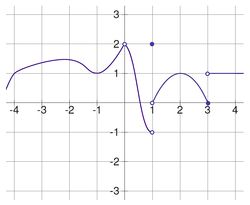Week4a
Activities
Activity: interpreting limits from a graph.
Below is the graph of a function f:
Compute the following limits. Note that some of your answers will only be approximate.
a) $f(0)$
b) $f(1.5)$
c) $f(1)$
d) $f(0.9)$
e) $f(1.1)$
f) $\lim_{x\rightarrow 1^+} f(x)$
g) $\lim_{x\rightarrow 1^-} f(x)$
h) $\lim_{x\rightarrow 1} f(x)$
i) $f(1.9)$
j) $f(2.1)$
k) $\lim_{x\rightarrow 2} f(x)$
l) $f(f(1.9))$
m) $f(f(2.1))$
n) $\lim_{x\rightarrow 2^+} f(f(x))$
o) $\lim_{x\rightarrow 2^-} f(f(x))$
p) $\lim_{x\rightarrow 2} f(f(x))$
q) $\lim_{x\rightarrow -1} f(f(x))$
r) $\lim_{x\rightarrow 4} f(f(x))$
s) $\lim_{x\rightarrow -4} f(f(x))$
t) $\lim_{x\rightarrow 0} f(1+x^2)$
u) $\lim_{x\rightarrow 0} f(\cos{x})$
Clicker Questions
Question.
The statement, “Whether or not $\lim_{x\rightarrow a} f(x)$ exists depends on how $f(a)$ is defined,” is true
a) Never.
b) Sometimes.
c) Always.
Question.
If a function $f$ is not defined at $x=a$, then
a) $\lim_{x\rightarrow a} f(x)$ cannot exist.
b) $\lim_{x\rightarrow a} f(x)$ could be 2.
c) $\lim_{x\rightarrow a} f(x)$ must approach infinity.
d) Not enough information.
